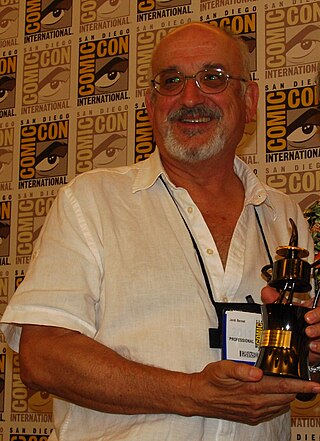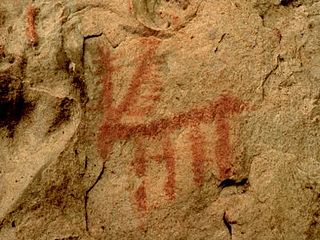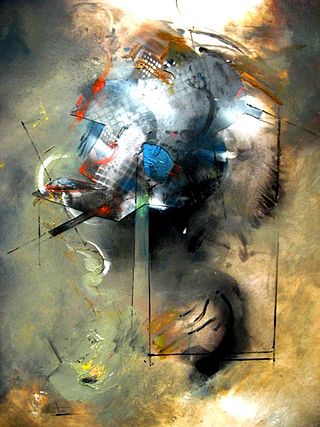
Frederick "Fred" Flintstone is the main character of the animated sitcom The Flintstones, which aired during prime-time on ABC during the original series' run from 1960 to 1966. Fred is the husband of Wilma Flintstone and father of Pebbles Flintstone and together the family live in their homely cave in the town of Bedrock. His best friend is his next door neighbor, Barney, who has a wife named Betty.

The Cave of Altamira is a cave complex, located near the historic town of Santillana del Mar in Cantabria, Spain. It is renowned for prehistoric cave art featuring charcoal drawings and polychrome paintings of contemporary local fauna and human hands. The earliest paintings were applied during the Upper Paleolithic, around 36,000 years ago. The site was discovered in 1868 by Modesto Cubillas and subsequently studied by Marcelino Sanz de Sautuola.

TBO was a long-running Spanish comic book magazine, published in Barcelona between 1917 and 1998.

José Luis Cuevas was a Mexican artist, he often worked as a painter, writer, draftsman, engraver, illustrator, and printmaker. Cuevas was one of the first to challenge the then dominant Mexican muralism movement as a prominent member of the Generación de la Ruptura. He was a mostly self-taught artist, whose styles and influences are moored to the darker side of life, often depicting distorted figures and the debasement of humanity. He had remained a controversial figure throughout his career, not only for his often shocking images, but also for his opposition to writers and artists who he feels participate in corruption or create only for money. In 1992, the José Luis Cuevas Museum was opened in the historic center of Mexico City holding most of his work and his personal art collection. His grandson Alexis de Chaunac is a contemporary artist.

The caveman is a stock character representative of primitive humans in the Paleolithic. The popularization of the type dates to the early 20th century, when Neanderthals were influentially described as "simian" or "ape-like" by Marcellin Boule and Arthur Keith.

The Great Gazoo, or simply Gazoo, is a fictional character from the animated series The Flintstones. He first appeared on the show on October 29, 1965. The Great Gazoo was voiced by actor Harvey Korman.

Betty Rubble is a fictional character in the television animated series The Flintstones and its spin-offs and live-action motion pictures. She is the black-haired wife of caveman Barney Rubble and the adoptive mother of Bamm-Bamm Rubble. Her best friend is her next-door neighbor Wilma Flintstone.
Oscar González Loyo was a comic book artist, author of Karmatrón y Los Transformables. González Loyo was the son of late comic book artist Oscar González Guerrero. He was also the founder and a main partner of the company ¡Ka-Boom! Estudio.
Horacio Miguel Sandoval Pérez is a comic book artist, member of !Ka-Boom¡ Estudio.

Jordi Bernet Cussó is a Spanish comics artist, best known for the gangster comics series Torpedo and for American weird western comic book Jonah Hex.
Cuevas or Cueva may refer to:
Carlos Trillo was an Argentine comic book writer, best known for writing the Cybersix comics.

Enrique Sánchez Abulí is a Spanish comics author, well known for his participation in the Spanish comics industry. His most famous work is the darkly comical gangster comics saga Torpedo in collaboration with Jordi Bernet.

Antonio Segura was a Spanish comics writer.
Notable events of 2009 in comics.

Cueva de la Olla is an archaeological site located in the Valle de las Cuevas in the northwest of Chihuahua, Mexico. It is approximately 47 km southwest of Nuevo Casas Grandes and is near the Ignacio Zaragoza Ejido.

The Cave of Bacinete is a cave located in Los Alcornocales Natural Park, Los Barrios, province of Andalusia, south Spain. It contains examples of prehistoric rock art and was declared Property of cultural interest in 1985.

Generación de la Ruptura is the name given by art critic Teresa del Conde to the generation of Mexican artists against the established Mexican School of Painting, more commonly called Mexican muralism post World War II. It began with the criticisms of José Luis Cuevas in the early 1950s, followed by others who thought the established art had become dogmatic, formulaic and nationalistic and the artists too deferential to the government. This new generation of artists was not bound by a particular artistic style but was more interested in personal rather than social issues and influenced by a number of international trends in art such as Abstract expressionism. Early reaction to them was strong and negative but by the end of the 1950s, they had succeeded in having their art shown in the major venues of Mexico. The Generación de la Ruptura had influence on other arts in Mexico, such as literature but it did not end the production of murals in Mexico with social and nationalist purposes.
Miquel Bernet Toledano, better known by the pseudonym Jorge, was a Spanish comic artist. His most famous character is Doña Urraca.











